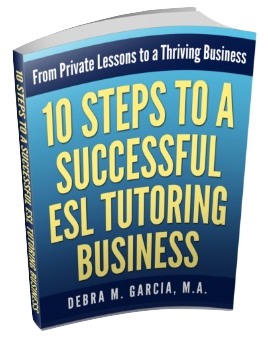ESL Future Perfect Continuous
How to Teach the Future Perfect Continuous
Tense to ESL and EFL Learners
The ESL Future Perfect Continuous verb tense is one of the last tenses taught to ESL and EFL learners.
This page explains the three components (conjugation, form, and function) that teachers must include in a lesson or lessons on this tense (also called the Future Perfect Progressive).
For a thorough discussion on how to teach verb tenses to ESL and EFL students, see my page on Teaching ESL Verb Tenses.
ESL Future Perfect Continuous Conjugation
The Future Perfect Continuous (or Future Perfect Progressive) is constructed this way:
- subject + will have been + -ing
The verb conjugation is the same for all subjects, however, this verb tense has the longest string of words; so it's often difficult for English language learners to consistently get the order right.
Here are some examples of ESL Future Perfect Continuous verbs with I, you, he/she/it, they, and we.
- I will have been talking. I will have been walking. I will have been dancing. I will have been eating.
- You will have been talking. You will have been walking. You will have been dancing. You will have been eating.
- She/He/It will have been talking. She/He/It will have been walking. She/He/It will have been dancing. She/He/It will have been eating.
- They will have been talking. They will have been walking. They will have been dancing. They will have been eating.
- We will have been talking. We will have been walking. We will have been dancing. We will have been eating.
ESL Future Perfect Continuous Forms
Here are the Future Perfect Continuous forms all English language students must learn.
- Affirmative Usage (I will have been teaching. You will have been teaching. She/He/It will have been teaching. They will have been teaching. We will have been teaching.)
- Negative Usage (I won't have been studying. You won't have been studying. She/He/It won't have been studying. They won't have been studying. We won't have been studying.)
- Yes/No Questions (Will I have been learning? Will you have been learning? Will she/he/it have been learning? Will they have been learning? Will we have been learning?)
- Short Answers* (Yes, I will have. No, I won't have. Yes, you will have. No, you won't have. Yes, she/he/it will have. No, she/he/it won't have. Yes, they will have. No, they won't have. Yes, we will have. No, we won't have.)
- WH- Questions (e.g., How long will the children have been sleeping?)
*Note: The Short Answer can also include "been" at the end of the sentence; for example, "Yes, I will have been."
Function of Future Perfect Continuous Tense
The ESL Future Perfect Continuous is used to emphasize the duration of an activity that will be in progress before another time or event in the future.
Here are some examples:
- She will have been sleeping for only four hours when the alarm goes off.
We will have been driving for fifteen hours by the time we arrive in Los Angeles.
At midnight, I will have been studying English grammar tenses for three hours.
Also, the activity that will be in progress before the other time or event in the future may be something that started in the past.
For example:
- He is going to move next year. He will have been living in the same house for twenty years when he moves.
ESL Student Challenges
The Future Perfect Progressive tense can sometimes be used interchangeably with the Future Perfect.
For example:
- He is going to move next year. He will have lived in the same house for twenty years when he moves. or He will have been living in the same house for twenty years when he moves.
- It's 11 p.m. At midnight, I will have studied English grammar tenses for three hours. or I will have been studying English grammar tenses for three hours.
Remind the student that the Continuous/Progressive tense is used when you want to emphasize the duration of an activity. This will help the ESL learner to distinguish when to use each of these two tenses more effectively.
Additional Resource
Azar's, Understanding and Using English Grammar is an excellent textbook for help with the ESL Future Perfect Continuous. I use it regularly with my intermediate and advanced students. It includes exercises and excellent explanations for all verb tenses as well as many other grammar points.
From ESL Future Perfect Continuous
to Teaching ESL to Adults Home Page


New! Comments
Have your say about what you just read! Leave me a comment in the box below.